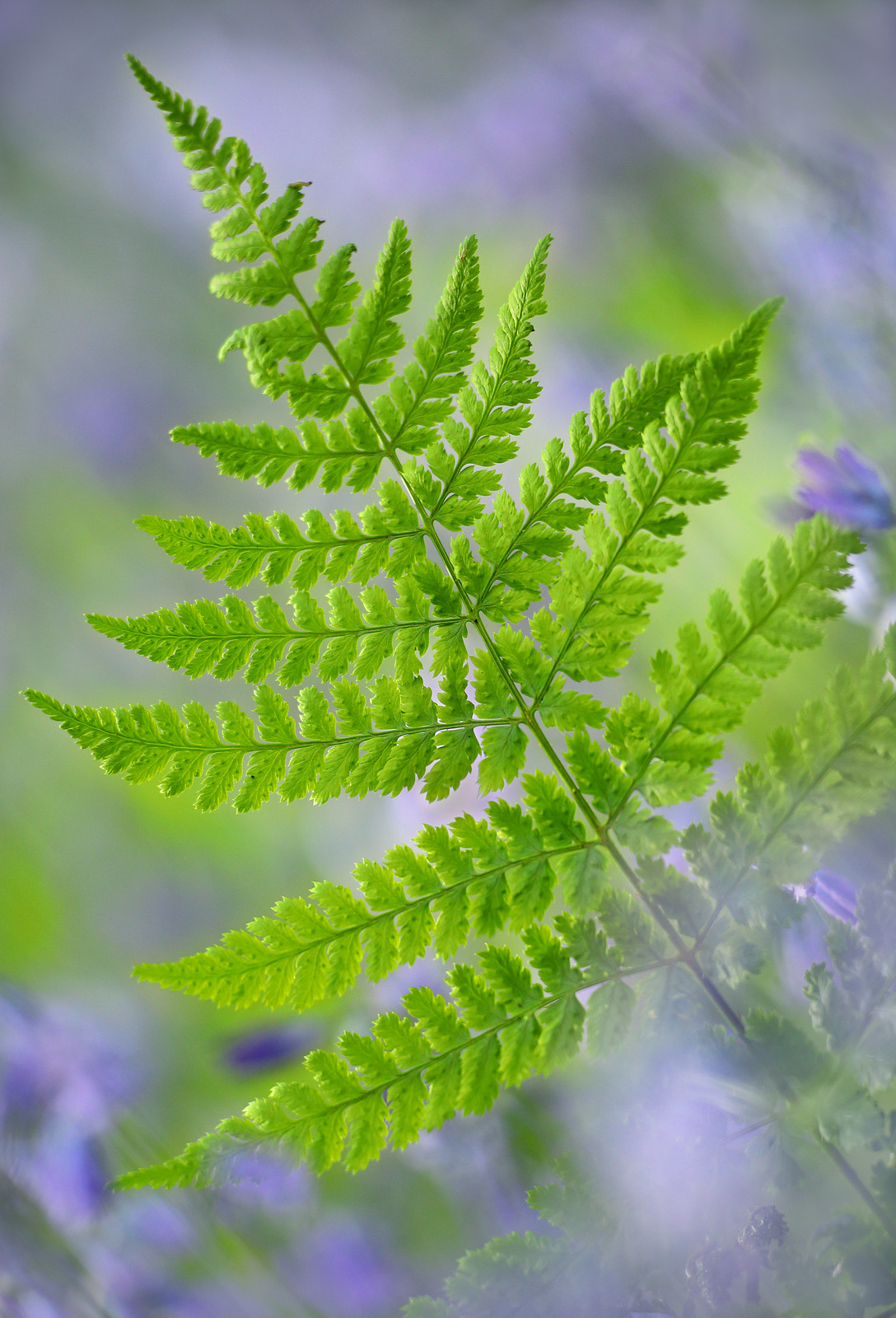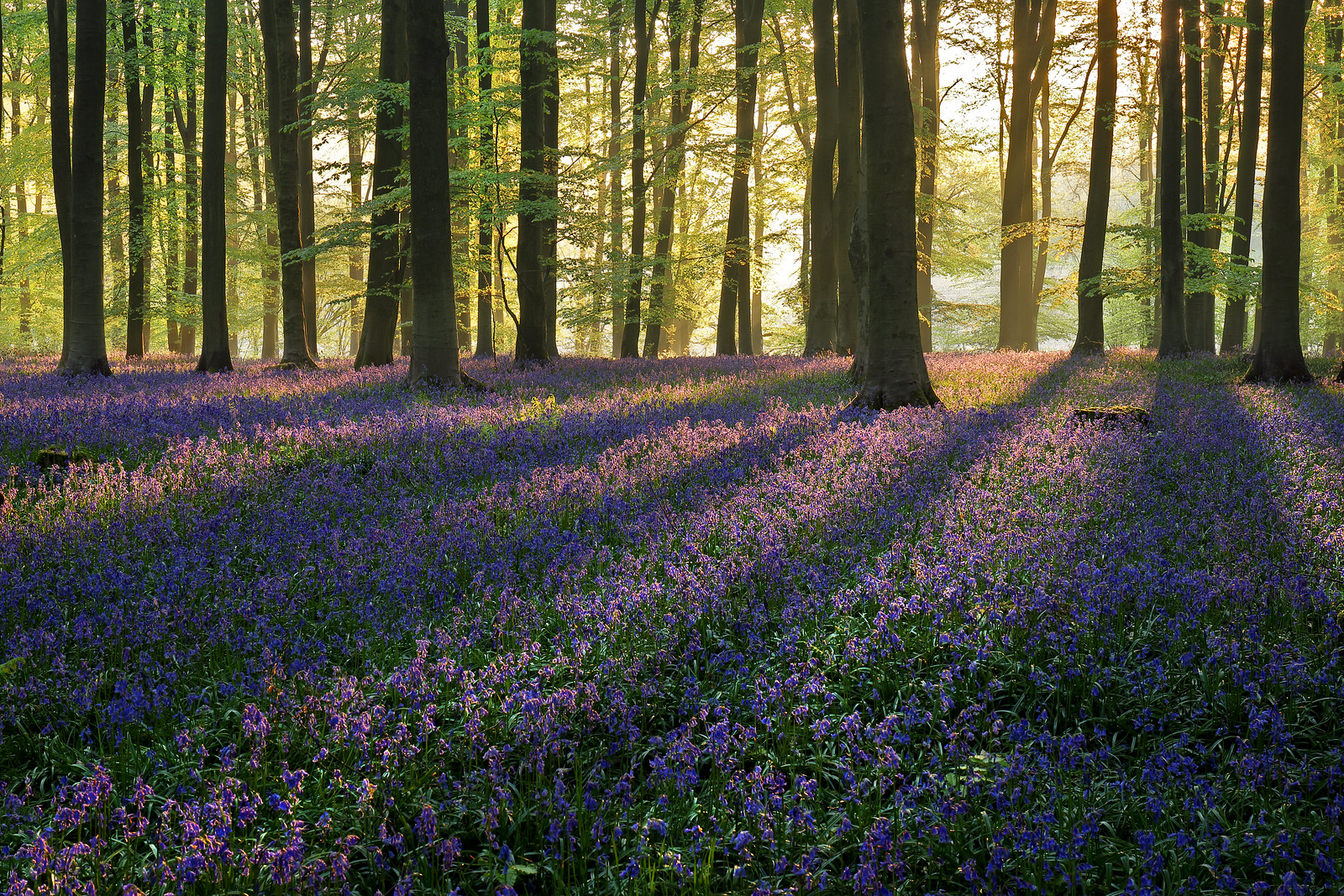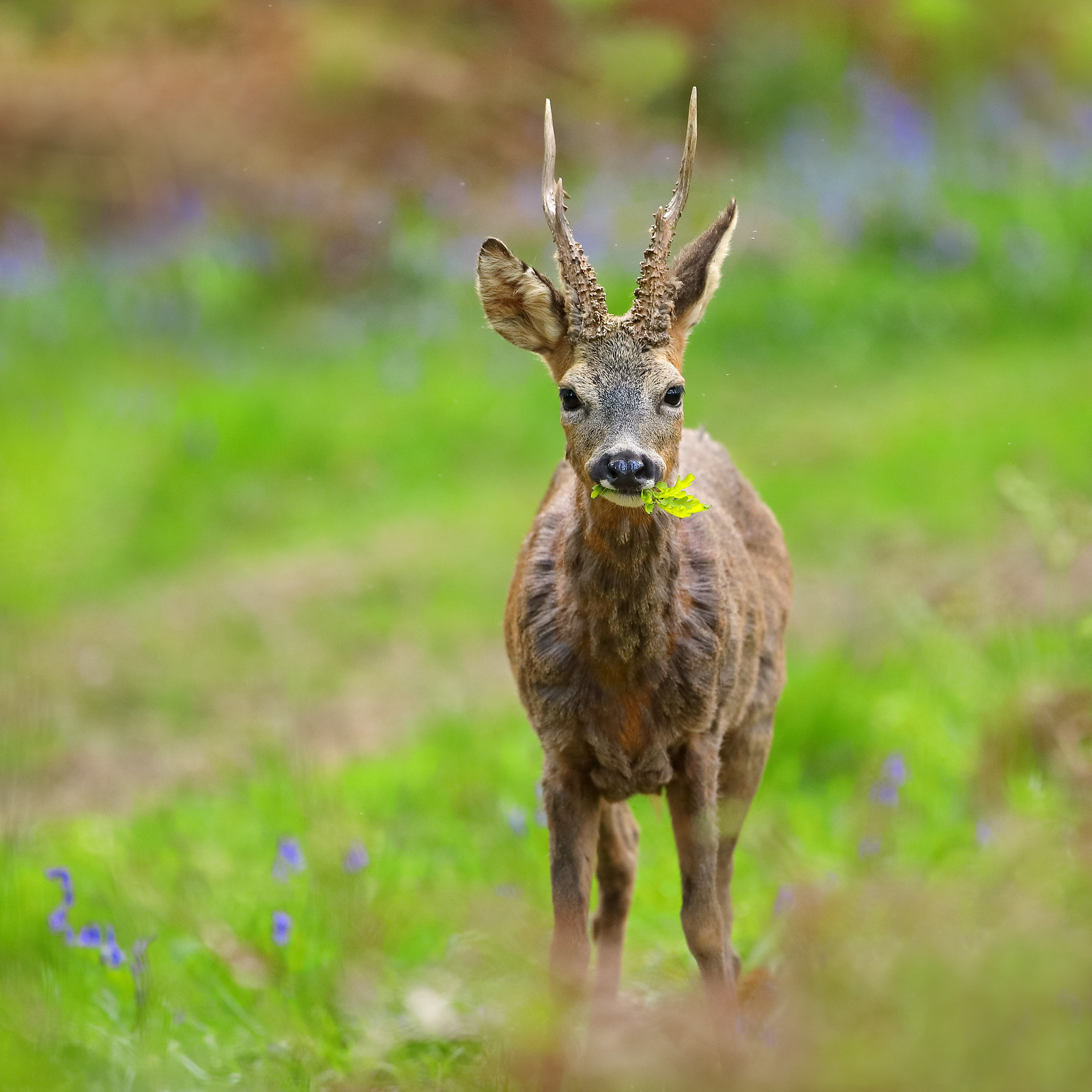Bluebell Woodland Project 2019
Welcome to my bluebell woodland project for 2019. I hope you enjoy looking at my photos as much as I enjoyed visiting beautiful bluebell woodlands in Hampshire and West Sussex over the last two weeks. Please leave a comment, if you like.
Bluebell woodlands are easy to photograph, but very challenging to photograph well. It is tempting to get carried away, without giving much thought to composition, exposure, focal length, viewing angle and lighting. I am all too aware of the many difficulties photographing bluebells, which is why I enter bluebell woods, looking for distinctive subjects, many hours before I intend to begin any photography. I am always looking for groupings of tall flower heads, uncoiling ferns, white bluebells, deer and any other elements, which will help me produce something truly memorable.
I am also very tempered about positive feedback — once again this spring, I have seen quite talented photographers lauding bluebell images that I would have immediately deleted due to the serious technical flaws of softness, underexposure and amateurish execution. Why photographers who are good judges of their own work can be such poor judges of others is something I cannot figure out. While my word on quality isn't the last, I do know a thing or two about photography and I find it much more useful to trust my own judgement, rather than the often spurious opinions of people who ought to know better. Sadly, those receiving specious praise will come away thinking they've taken something quite special and feel encouraged to repeat their substandard efforts in future, which is another reason why I distance myself emotionally from feedback.
It's best to keep things simple and uncluttered, with no more than three visual elements in the frame. Carpets of bluebells look best when debris, such as fallen branches are absent. Bluebells have quite delicate colouring and their appearance is strongly affected by lighting conditions. For best results in the early morning or late evening sun, choose a bluebell site close to the edge of the woods, where sunlight can reach through gaps between trees. Bright, but sunless weather is also good, especially when the bluebells are situated away from the edge of a woodland and direct sunlight is not an option. For detail shots, I use a 300mm or 500mm lens and an extension tube for close focussing. When taking landscape shots, I prefer focal lengths 40mm - 70mm to slightly compress the perspective and make the bluebells appear close together. The use of a polarising filter cuts out reflections on foliage and improves the colour green.

Bluebell woodlands are easy to photograph, but very challenging to photograph well. It is tempting to get carried away, without giving much thought to composition, exposure, focal length, viewing angle and lighting. I am all too aware of the many difficulties photographing bluebells, which is why I enter bluebell woods, looking for distinctive subjects, many hours before I intend to begin any photography. I am always looking for groupings of tall flower heads, uncoiling ferns, white bluebells, deer and any other elements, which will help me produce something truly memorable.
I am also very tempered about positive feedback — once again this spring, I have seen quite talented photographers lauding bluebell images that I would have immediately deleted due to the serious technical flaws of softness, underexposure and amateurish execution. Why photographers who are good judges of their own work can be such poor judges of others is something I cannot figure out. While my word on quality isn't the last, I do know a thing or two about photography and I find it much more useful to trust my own judgement, rather than the often spurious opinions of people who ought to know better. Sadly, those receiving specious praise will come away thinking they've taken something quite special and feel encouraged to repeat their substandard efforts in future, which is another reason why I distance myself emotionally from feedback.
It's best to keep things simple and uncluttered, with no more than three visual elements in the frame. Carpets of bluebells look best when debris, such as fallen branches are absent. Bluebells have quite delicate colouring and their appearance is strongly affected by lighting conditions. For best results in the early morning or late evening sun, choose a bluebell site close to the edge of the woods, where sunlight can reach through gaps between trees. Bright, but sunless weather is also good, especially when the bluebells are situated away from the edge of a woodland and direct sunlight is not an option. For detail shots, I use a 300mm or 500mm lens and an extension tube for close focussing. When taking landscape shots, I prefer focal lengths 40mm - 70mm to slightly compress the perspective and make the bluebells appear close together. The use of a polarising filter cuts out reflections on foliage and improves the colour green.


Another mild winter caused the early emergence of bluebells, so I began my time off just as the flowers were beginning to wilt. It was hard at times to find pristine flowers. The exceptionally dry weather was also a factor in early wilting. While bluebells in beech forests wilt early, this isn't the case at one of my privately owned sites in West Sussex, where the flowers take much longer to grow and last until mid-May.

It's not easy being a wildlife and landscape without a car, but out of personal commitment to tackling the climate emergency, I purchased an electric bicycle last summer. Trains can take me within several miles of a site, but carrying very heavy equipment over this distance is too much, even on a conventional bike. The e-bike has opened up new opportunities for me and I wasted no time in visiting Micheldever Wood in Hampshire. After stopping at Micheldever Station, I breezed through picturesque country lanes towards the beautiful chocolate box village of Micheldever itself. I continued to the A33, where I reached 40 mph downslope and arrived at Itchen Wood just 14 minutes after setting off.
The photos paint a tranquil picture of Micheldever and Itchen Woods, but I found the workload relentless, as my unfamiliarity with the sites meant extensive scouting. I can only carry so much food and drink, but I used a nearby service station for an evening meal and to buy extra water/gin and tonic. I had not yet sourced a tent and inflatable mattress small enough to carry on my panniers, which unfortunately meant a hellishly cold, damp, uncomfortable and sleepless night in the open. Cold and exhausted, I made my way up to the north end of Micheldever Wood for the sunrise, achieving my long-standing ambition to photograph the famous bluebell wood at dawn, before walking all the way back to the southern tip of Itchen Wood to catch the deer. I still had to cycle to the railway station, but just 3 hours after leaving Itchen Wood, I was at home, looking at the images on my computer.
When I return to Micheldever in spring 2020, I will pack the ultra light trekking tent and inflatable mattress I have just purchased from Decathlon to ensure a good night's sleep, which in turn will help me maximise the time spent at this wonderful location. Camping will help me to photograph other subjects in early morning, such as deer and resting butterflies. So keep your eyes peeled for my dawn adventures this summer and for the avoidance of any doubt, I promise to behave when loitering within tent, protecting the environment and maintaining the tolerance of landowners.



Beech forests are an ideal growing environment for bluebells. The relatively late emergence of leaves allows bluebells plenty of light when they start growing in late winter, while the dense leaf canopy over the summer restricts growth of competing plants. The relative lack of nutrients from fallen, decaying beech leaves further restricts growth of other plant species.

When this Roe deer wandered into a carpet of bluebells, she unwittingly helped me achieve a photographic milestone. Roe deer shed their winter coat at this time of year, making them look very scruffy. Bucks looks particularly slovenly, shedding velvet, revealing bloodstains on their newly-formed antlers. Shedding does not cause them any suffering, but it's not a good look. I was glad that a sleeker female Roe deer turned up in the woods. She displayed no signs of alarm. One thing I wanted to avoid was a bad photo of a Roe deer in bluebells and there are many disorganised images out there being praised simply because they tick a couple of boxes. There is room for improvement in my shot; I would have preferred softer, warmer lighting earlier or later in the day, but it's nonetheless an image which just about meets my standards. Had I been in the woods during the golden hour, the presence of other photographers would have disturbed the deer, so mid-afternoon is a compromise I may have to live with.

Most Bluebells begin wilting in early May, but happily, I have access to a privately-owned West Sussex bluebell wood, which is always at least one week behind everywhere else. The valley location receives less light and bluebells have to compete with other plants. These factors slow down their growth. I never really want my bluebell projects to end, but this woodland allows the fun to continue for a little while longer. The woodland is a highly complex network of paths, streams and undulating hills, making the site harder to photograph than Micheldever. The stream seen here is fed by a spring emerging out of High Weald sandstone further east in the forest. Lack of rainfall this season has left the stream very low on water. The normally squelchy ground is rock hard.


It would be easy to take our annual bluebell displays for granted. Bluebells are a wild woodland flower of temperate climates. But all of this may change as increasing global average temperatures threaten the future of English bluebells. An increase of 5°C by 2100 above 1850 figures would put the UK into either a humid subtropical or Mediterranean climate category, depending on rainfall distribution. As spring 2019 has already shown, bluebells are beginning to slip out of sync with seasons, with flowers appearing in mid-March. It's thought that bluebells lack the flexibility to adapt quickly enough to flourish in rising temperatures. Wild flowers are also threatened by illegal bulb harvesting by criminals for sale on the black market, which is why it's always best to source garden bulbs from legitimate sources.

I hadn't seen Roe deer in this privately owned forest for three years, but two turned up in one minute. This buck was the most tolerant of the pair. There is often something quite child-like about Roe deer; the pretty eyes, dinky legs and everything in miniature. He looked back at me, before reaching down to pick up and eat a fallen clump of oak leaves. His antlers were so long, I had trouble framing the picture. His younger companion had already fully shed his winter coat, but his will be gone in another two weeks. It was fitting that the last photo of my project was of my favourite wild animal.
As my bluebell photography project comes to an end, I can look back and wish I had spent longer at Micheldever and Itchen Woods. There are many possible vantage points for landscape photography and the site is rich in wildlife. I didn't get the time to photograph any Brimstone and Orange Tip butterflies or the Stoats, Fallow and Muntjac deer either. Next year, I will be staying for two nights, in greater comfort and warmth, of course. The bluebell season is over so quickly and there is only so much I can fit in, without falling asleep on the job. I did my best. I hope you've enjoyed yourself.
Comments